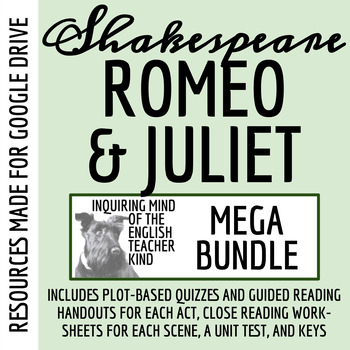Romeo and Juliet Bundle - Reading Guide, Quizzes, Test, Close Readings (Google)
- Google Slides™

What educators are saying
Products in this Bundle (36)
showing 1-5 of 36 products
Description
This low-prep bundle covering Romeo and Juliet by William Shakespeare contains all the formative and summative assessments teachers need to assess general reading comprehension, support the development of close reading analysis skills, and reduce take-home grading responsibilities. Included are five multiple choice quizzes, each covering a single act; five reading guides, each covering a single act; twenty-five close reading worksheets, each covering a single scene; an end-of-unit test; and answer keys. Materials are made for Google Drive, offering self-grading functionality for multiple choice questions. (Alternatively, a printable bundle option is available.)
By engaging with these resources, students will have opportunities to:
- Identify what the text states explicitly and implicitly
- Understand the context of meaningful quotations in the play
- Define complex words as they are used in the text
- Discern the intended effect of Shakespearean slang and figurative language as they are used in context
- Explore how complex characters think, behave, develop, and interact
- Think from the perspective of Romeo and Juliet in order to answer a question about symbolism
- Use context to identify an opinion with which Friar Laurence would agree
- Apply knowledge of literary devices including metaphor, simile, hyperbole, allusion, personification, oxymoron, dramatic irony, situational irony, and more
- Determine the tone of given passages
- Discern the functions of given passages
- Examine the greater significance of a given detail
- Compare elements of one scene with those of another
- Conduct brief research on a variety of subjects including allusions to obscure mythological creatures and the author's biography
- Argue whether Friar Laurence's decision to assist Juliet is consistent or inconsistent with his moral and religious duties
- Explore relevant themes in the context of a scene
- Respond to an essay prompt requiring students to evaluate tragic mistakes characters make
- Support claims with relevant textual evidence
- Write about Shakespearean drama with clarity, accuracy, and precision
Materials in this bundle may facilitate small-group discussions in which students decode language and pose/respond to questions relating to plot, broad topics, and character development. Using these resources for structured guidance, students will improve their ability to present information, conclusions, and supporting textual evidence clearly and convincingly.
Materials are available for teaching a variety of Shakespeare's plays:
- Hamlet - Google and printable
- Julius Caesar - Google and printable
- King Lear - Google and printable
- Macbeth - Google and printable
- Othello - Google and printable
- Romeo and Juliet - Google and printable
- The Merchant of Venice - Google and printable
- The Taming of the Shrew - Google and printable
- The Tempest - Google and printable
* This resource is also included in a whole store growing bundle.





